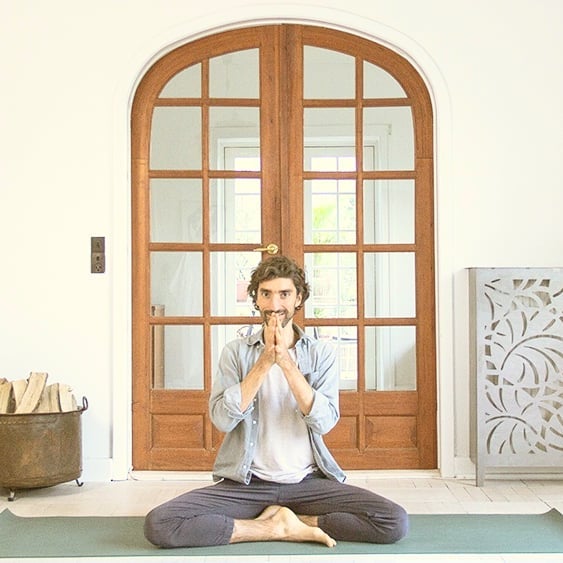Anjali mudra; perhaps the most well-known hand gesture in the yoga world. As you arrive on your mat or are about to leave it, you gently press your hands into each other, perhaps bowing your head towards your heart. “Set an intention,” “express gratitude to yourself or someone(-thing) else”, or something along these lines is often what instructors will guide you to do before or after a yoga class.
However, just the idea of bringing hands into each other in “praying” position can awaken resistance in some of us. What are we exactly bowing to or for? Why bring our hands in prayer at all? These are valid questions, which every yogi must have asked themselves at some point. Why is the so-called “Anjali mudra” or prayer-hand position, or even simply the usual namaste-hands such a strong ritual that belongs to nearly every yoga class?
In the Indian tradition and several other Asian cultures, this gesture is used as a sign of salutation, reverence, and the honoring of the person(s) we are facing and acknowledging in this way. Almost similar to the “Namaskar mudra”, or salutation sign, “Anjali mudra” generally involves the pointing of the thumbs towards the chest, or thumbs resting on the sternum, and a slight opening between the palms, which symbolizes the divine offering quality of the gesture. Indeed, the root “anj-” literally means celebration or offering, and thus in a yoga practice context Anjali implies reverence to spirit, grace, source—whatever name we prefer using—and a humble acknowledgement of a greater purpose behind our practice. I personally like the slight widening of the palms, a space in which we can symbolically place our own offering, dedication or intention expressed through the efforts and commitment to the practice.
In the context of the Shiva Tantra philosophy and tradition, which stems from nondual lineages, Anjali mudra resembles Hridayanjali mudra, literally the celebration-of-the-heart seal or sign. If the Heart is the spiritual center where the inner and outer meet each other, Anjali mudra connotes the intentional offering of our Heart through the practice, as we are about to engage in it or close it.
Whether you adhere to the Tantrik approach or not, the Anjali or Namaskar mudra is an invitation to bring a sense of humility and dedication, a sense of selflessness or simple generosity to what you consciously engage into; aka a form of practice.
Offering… Only the Good?
If you have been to class with me, you know how I like to teach asana inspired by a theme, an invitation to connect to a greater perspective as we move. The other day, while weaving in the theme of “openness” in-between poses, I invited people in the class to reflect onto what they were offering through their practice. While it felt like it worked well and was inspiring for most folks, after the class a student reported how, by the end of the session, they felt they had nothing more to offer. They ended up a little upset or emptied out, which certainly was not my initial intention!
As the class setting permitted it, we discussed in group how “offering” in the context of the yoga tradition is not only about giving love and our greatest energy. Perhaps due to the production-focus of our modern society, we might have internalized that we need to be “on top of it” and only have something “of positive value” if we are to contribute to this world and share something.
How about, then, times when we feel depleted, uneasy, sad or even hopeless? Many of us—me included—would think that, when inhibited by a challenging mental or emotional state, we should retreat and hide. Instead, what if offering our heart as it is, no matter how tumultuous it might feel like, was just enough—and even perfect?
As you might already feel, yoga and the eastern traditions carry many layers that one could just continue to peel and explore each day, one after the other. Anjali mudra, as I see it, is an invitation to offer and share who we are in the moment that we do it. Even on a challenging day, rather than avoiding the practice or thinking there is nothing to offer, a possibility is to bring in one’s experience of powerlessness or exhaustion about the challenge (“I feel overwhelmed and do not know what to do, and I offer this to my practice today” or “I am sad and stuck in a narrative of unworthiness, or in resentment, it’s hard to distance myself from it but I offer it to my practice”) and turn it into an offering.
I am sure you start getting the idea that the invitation here is not to sacrifice oneself, so to speak, and just give everything we got recklessly but rather to find the balance between self-awareness and selflessness, i.e. an eastern concept about dissolving the limited perception of self or ego.
My favorite go-to offering as I start my practice is to offer my attention, my presence, and a prayer to stay grounded and centered. The practice then becomes a playground or training field to cultivate presence which I wish will continue after I roll my mat and put it back in place again.
Karma, and an “Offering Attitude”
You have heard about karma, I guess. Karma means “action” and is subject to the laws of cause and effect, so that every action we take comes from somewhere and bears a consequence, whether we intentionally wish for it (“I am eating to feed my body”) or not (“I am surrendering to my craving for more sugar or coffee”). If I eat, I will calm my hunger, but if I act on the compulsion of eating something that will bring me out of balance, I might feel uncomfortable physically, more numb, and even guilty as a result.
Similarly, every word I write here undeniably has an effect. My hope is that they all land well on your side but, ultimately, I have no control over this. Whether our actions, words, and even thoughts are virtuous or not, as they arise and manifest in the world they directly come with a consequence, and in an ideal world such consequences align with the virtuosity of our actions, i.e. our intention. As overwhelming that it might sound, the laws of karma simply define how we design our lives individually and collectively, hopefully for the greater good. Good chances are, yoga says, that if our intention behind our actions, thoughts, and words is clear, so will be their consequence.
Therefore, when we set an intention or offer dedicatedly our heart to whatever we engage onto, as Anjali mudra suggests, we can impact the order of things in a powerful way. For example, next time you choose to use your time and energy onto a particular task or chore, reflect about what you are offering through your efforts. Even as you begin your day, start driving or biking somewhere, you start to think about an intention for your day. “I offer my heart today”, “I offer my longing for belonging and connection today”, “I set the intention to stay warm and kind towards myself and others”, “I set the intention to pause and rest for 20 min today”… are just examples of how I would do it. Even if it is laundry, checking in at work, or grocery shopping, we can always do it with an intention.
Now the question is…
What intention do YOU choose today?
With gratitude and warmth
Cédric


